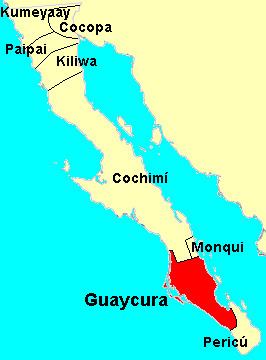Extinct before 1800 | Ethnicity Guaycura ISO 639-3 None (mis) | |
 | ||
Language family unclassified(Guaicurian) Linguist list qjg Guaicura (Waikura, Waykuri) | ||
Waikuri (Guaycura, Waicura) is an extinct language of southern Baja California spoken by the Waikuri or Guaycura people. The Jesuit priest Baegert documented words, sentences and texts in the language between 1751 and 1768.
Contents
Waikuri may be, along with the Yukian and Chumashan languages and other languages of southern Baja such as Pericú, among the oldest languages established in California, before the arrival of speakers of Penutian, Uto-Aztecan, and perhaps even Hokan languages. All are spoken in areas with long-established populations of a distinct physical type.
Classification
Baegert's data is analyzed by Raoul Zamponi (2004). On existing evidence, Guaycura appears to be unrelated to the Yuman languages to its north. Some linguists have suggested that it belonged to the widely scattered Hokan phylum of California and Mexico (Gursky 1966; Swadesh 1967); however, the evidence for this seems inconclusive (Laylander 1997; Zamponi 2004; Mixco 2006). William C. Massey (1949) suggested a connection with Pericú, but the latter is too meagerly attested to support a meaningful comparison. Other languages of southern Baja are essentially undocumented, though people have speculated from non-linguistic sources that Monqui (Monquí-Didiú), spoken in a small region around Loreto, may have been a 'Guaicurian' language, as perhaps was Huchití (Uchití), though that may have actually been a variety of Guaycura itself (Golla 2007).
The internal classification of Gauicurian (Waikurian) languages is uncertain. Massey (1949), cited in Campbell (1997:169), gives this tentative classification based on similarity judgments given by colonial-era sources, rather than actual linguistic data.
However, Laylander (1997) and Zamponi (2004) conclude that Waikuri and Pericú are unrelated.
Phonology
Waikuri had four vowels, a e i u. We don't know if there was vowel length. Consonants were voiceless stops p t č k and maybe glottal stop; voiceless b d, nasal m n ny, flap r, trill rr, and approximants w y.
Grammar
The little we know of Guaycura grammar was provided by Francisco Pimentel, who analyzed a few verbs and phrases. Guaicura was a polysyllabic language that involved a lot of compounding. For example, 'sky' is tekerakadatemba, from tekaraka (arched) and datemba (earth).
Beagert and Pimentel agree that the plural is formed with a suffix -ma. However, Pimentel also notes a prefix k- with the 'same' function. For example, kanai 'women', from anai 'woman'. According to Pimentel, the negation in -ra of an adjective resulted in its opposite, so from ataka 'good' is derived atakara 'bad'.
Pronouns were as follows (Golla 2011):
Text
The Pater Noster is recorded in Guaycura, with a literal gloss by Pimentel (1874: cap. XXV).
